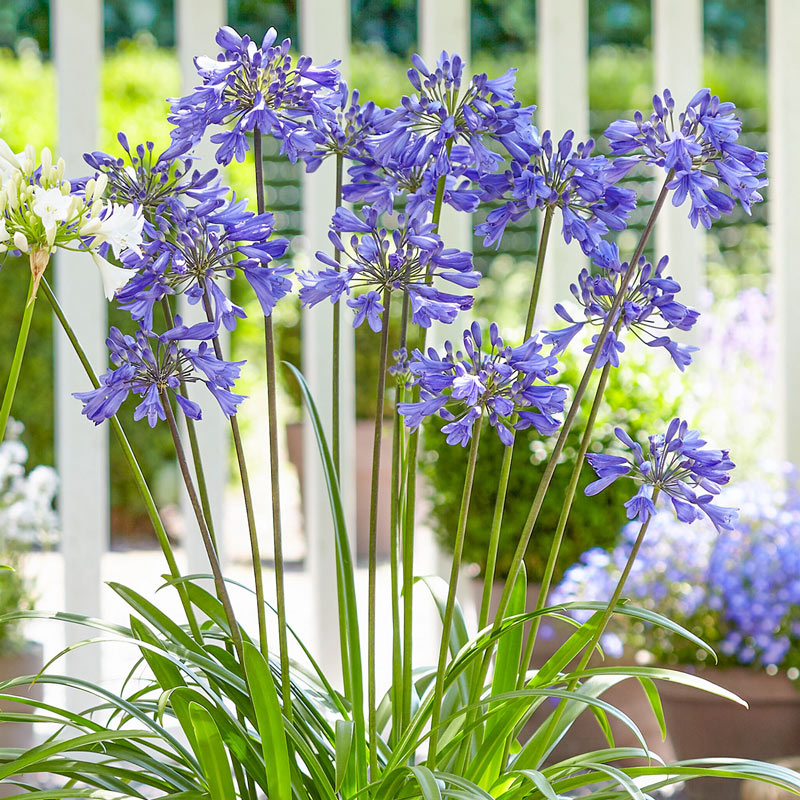Spectacular Agapanthus: Enhancing Your Yard's Charm
Spectacular Agapanthus: Enhancing Your Yard's Charm
Blog Article
Understanding the Art of Agapanthus Care: Essential Actions for Healthy Development and Lively Blooms
In the realm of gardening, the cultivation of agapanthus stands as a fulfilling undertaking for those who look for to nurture these stylish flowering plants. With their striking blooms and elegant vegetation, agapanthus has actually captured the attention of garden enthusiasts worldwide. Nonetheless, accomplishing optimum development and vivid blossoms calls for a nuanced method that encompasses different essential actions. From selecting the best selection to mastering trimming techniques, the journey in the direction of cultivating flourishing agapanthus plants is diverse and holds the key to opening the full possibility of these agricultural gems.

Selecting the Right Agapanthus Variety

When selecting the appropriate Agapanthus selection for your garden, consider elements such as environment suitability, bloom shade, and growth practice. Additionally, consider the environment in your region to ensure the Agapanthus variety you pick can prosper in your details problems. Understanding the development behavior of different Agapanthus selections is vital for correct placement within your yard.
Perfect Growing Problems
Thinking about the ideal ecological needs is important for successful Agapanthus growing. Agapanthus plants are sensitive to cold temperatures and need to be safeguarded from frost throughout winter months.
To ensure healthy development and vivid blooms, plant Agapanthus bulbs at a deepness of about 2-4 inches and area them 8-12 inches apart. Adding organic matter, such as garden compost, to the dirt can improve drain and fertility, advertising robust root advancement. Mulching around the base of the plants helps maintain moisture and subdues weed development. Normal watering is critical, specifically throughout the growing season, to maintain the dirt consistently wet yet not saturated.
Watering and Feeding Tips
Preserving correct moisture levels and offering essential nutrients are crucial elements in the care routine for Agapanthus plants. When it involves watering Agapanthus, it is critical to strike a balance. If overwatered, these plants favor constantly wet dirt but are at risk to root rot. Throughout the growing period, water deeply as soon as a week, making certain the soil is well-draining to avoid waterlogging. In hotter environments or throughout durations of dry spell, even more regular watering might be required to keep the dirt evenly wet. Nonetheless, lower watering in the wintertime to avoid water logged problems.
Fertilizing Agapanthus is crucial for advertising healthy you could try here and balanced Check This Out development and prolific flowers. Use a balanced plant food, such as a 10-10-10 formula, in the early springtime as new growth emerges. Repeat this application every 6-8 weeks throughout the growing period. Stay clear of extreme fertilizing, as it can result in lush vegetation at the cost of blossoms. Constantly comply with the producer's directions for appropriate dilution and application approaches. By adhering to these watering and feeding tips, you can ensure your Agapanthus plants flourish and create vivid, resilient blossoms.
Trimming Strategies for Agapanthus
Trimming Agapanthus plants at the proper times and with appropriate methods is vital for preserving their health and promoting optimum development and blooming. The suitable time to trim Agapanthus is in late winter season or early springtime before new development emerges.
For flowered stems, wait till the blossoms have actually withered and afterwards cut them back to the base. This not only cleans up the plant's look however likewise find more information motivates the advancement of brand-new blossom buds. Deadheading spent flowers can also reroute the plant's energy into producing even more blossoms as opposed to establishing seeds. Nonetheless, if you want to accumulate seeds for proliferation, leave some blossoms to completely dry and fully grown on the plant.
Remember to use tidy, sharp tools to make accurate cuts and reduce the risk of introducing diseases. Agapanthus. Regular trimming will certainly assist maintain your Agapanthus looking healthy and neat while ensuring an abundant display screen of lovely blossoms
Dealing With Common Bugs and Illness
After making sure proper trimming strategies for Agapanthus, it is necessary to address typical pests and conditions that can impact the health and wellness and vigor of these plants. One usual bug that affects Agapanthus is the Agapanthus gall midget.
One more common problem is fungal leaf place, which provides as dark lesions on the leaves. To avoid fungal illness, guarantee great air blood circulation around the plants, avoid overhead watering, and get rid of any kind of contaminated leaves promptly. Additionally, Agapanthus plants can struggle with origin rot if they are grown in inadequately draining dirt. To avoid this, plant Agapanthus in well-draining soil and avoid overwatering. By being cautious and taking punctual activity against diseases and insects, you can aid your Agapanthus plants thrive and create vibrant flowers.

Final Thought
To conclude, mastering the art of agapanthus care includes choosing the right selection, providing ideal growing conditions, appropriate watering and feeding, appropriate trimming techniques, and dealing with typical bugs and conditions. By complying with these crucial steps, you can ensure healthy growth and vibrant blossoms for your agapanthus plants. Bear in mind to regularly keep an eye on and keep your plants to advertise their general wellness and durability.
To make sure healthy and balanced growth and dynamic flowers, plant Agapanthus light bulbs at a deepness of regarding 2-4 inches and space them 8-12 inches apart. By adhering to these watering and fertilizing ideas, you can guarantee your Agapanthus plants grow and create vivid, durable flowers.
One typical pest that impacts Agapanthus is the Agapanthus gall midge. In addition, Agapanthus plants can experience from origin rot if they are planted in badly draining pipes soil. By following these crucial steps, you can guarantee healthy and balanced development and lively blooms for your agapanthus plants.
Report this page